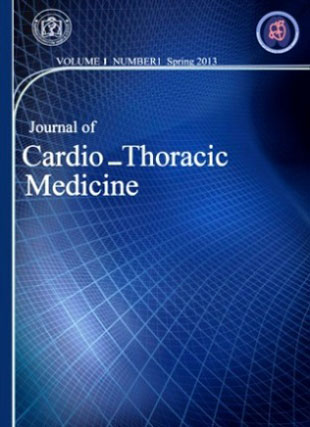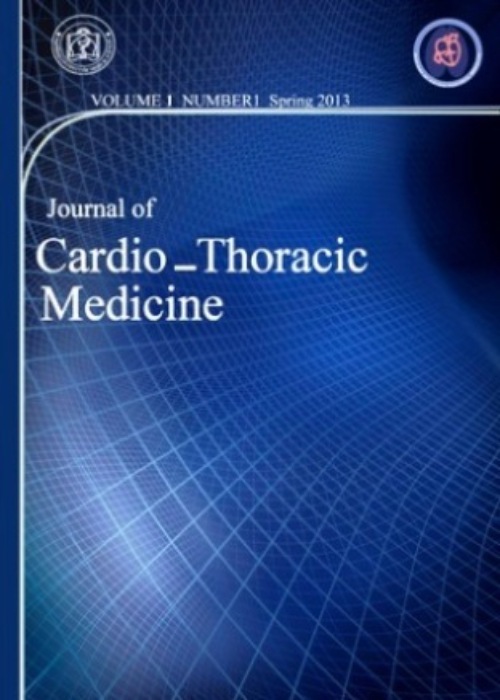فهرست مطالب

Journal of Cardio -Thoracic Medicine
Volume:2 Issue: 1, Winter 2014
- تاریخ انتشار: 1392/12/17
- تعداد عناوین: 9
-
-
Page 108Dear colleagues, Welcome to the fourth issue of the Journal of Cardio-Thoracic Medicine. We are grateful that with support and cooperation of our dear colleagues, the first year of JCTM publication passed successfully. We are expecting to promote the indexing of Journal of Cardio-Thoracic Medicine in the following year. In this issue, a valuable review article has been written by Dr.Corlateanu and colleagues, about the overlap syndrome between Asthma and Chronic Obstructive Pulmonary Disease. Due to the importance of these two conditions, I highly recommend you to read this article. Moreover, same as the previous issues, several original articles and an interesting case report have been published. We appreciate the collaboration of our international colleagues from Turkey and Moldova in this issue. Again, I would like to thank all of our colleagues for submitting their valuable studies to Journal of Cardio-Thoracic Medicine.I hope you will find the articles interesting to read.
-
Pages 109-112Asthma and chronic obstructive pulmonary disease (COPD) are highly prevalent chronic diseases in the general population. Both are characterized by similar mechanisms: airway inflammation, airway obstruction, and airway hyperresponsiveness. However, the distinction between the two obstructive diseases is not always clear. Multiple epidemiological studies demonstrate that in elderly people with obstructive airway disease, as many as half or more may have overlapping diagnoses of asthma and COPD. A COPD-Asthma overlap syndrome is defined as an airflow obstruction that is not completely reversible, accompanied by symptoms and signs of increased obstruction reversibility. For the clinical identification of overlap syndrome COPD-Asthma Spanish guidelines proposed six diagnostic criteria. The major criteria include very positive bronchodilator test [increase in forced expiratory volume in one second (FEV1) ≥15% and ≥400 ml], eosinophilia in sputum, and personal history of asthma. The minor criteria include high total IgE, personal history of atopy and positive bronchodilator test (increase in FEV1 ≥12% and ≥200 ml) on two or more occasions. The overlap syndrome COPD-Asthma is associated with enhanced response to inhaled corticosteroids due to the predominance of eosinophilic bronchial inflammation.The future clinical studies and multicenter clinical trials should lead to the investigation of disease mechanisms and simultaneous development of the novel treatment.Keywords: Asthma, COPD Overlap, Syndrome, Chronic Obstructive, Pulmonary Disease, Phenotypes
-
Pages 113-137IntroductionChronic obstructive pulmonary disease (COPD) secondary to sulfur mustard gas poisoning, known as mustard lung, is a major late pulmonary complications in chemical warfare patients. Serious comorbidities like dyslipidemia are frequently encountered in COPD. The aim of this study was to measure the serum lipid profile and evaluate the relation of lipid parameters with the severity of airway obstruction in mustard lung patients.Materials And MethodsThirty-six non-smoker mustard lung patients with no history of cardiovascular disease, diabetes mellitus, and dyslipidemia were entered into this cross-sectional study. Control group consisted of 36 healthy non-smoker men were considered in this study. Serum lipid profile was performed in the patients and the controls. Spirometry was done in mustard lung patients.ResultsThe mean age of the patients was 47±6.80 SD years. The mean duration of COPD was 18.50±7.75 SD years. There were statistically significant differences in mean serum triglycerides and total cholesterol levels between patients and controls (p=0.04 and p=0.03, respectively).The mean levels of lipid parameters were not statistically significant different among the 4 stages of COPD severity (p>0.05).ConclusionThe current study revealed that the serum levels of triglycerides and cholesterol are elevated in mustard lung patients compared with the healthy controls. Since lipid profile abnormalities are considered as a major risk factor for cardiovascular disease, especial attention to this matter is recommended in mustard lung patientsKeywords: Chronic Obstructive Pulmonary Disease, Lipid Profile, Spirometry, Sulfur Mustard
-
Pages 118-122IntroductionThe molecular mechanisms involved in pathogenesis of esophageal cancer have been the main concern of several studies. In this study, we aimed to investigate the changes of serum prooxidant-antioxidant balance (PAB) value as a redox index, as well as serum C-reactive protein (CRP) compared to healthy control group.Materials And MethodsIn a cross-sectional study, blood samples were drawn from 25 patients with esophageal cancer and 25 healthy subjects. Serum CRP and PAB value were measured in all samples according to relevant protocols.ResultsSerum CRP was significantly higher in our patients (14.3 ± 3.2 mg/L) compared to healthy control group (4.6 ± 1.4 mg/L), with a p-value of less than 0.001. The value of PAB in our patients (133.9 ± 21.7) was also higher than that of healthy subject (51.3 ± 11.2), indicating a redox perturbation in favor of oxidants.ConclusionThere was a significant increase in both serum PAB value and CRP in patients with esophageal cancer compared to the control group, which indicated both oxidative stress and inflammatory response in patients with esophageal cancer, respectively.Keywords: Antioxidant, CRP, Esophageal Cancer, Oxidative stress, Pro, oxidant
-
Pages 123-126IntroductionPneumonectomy is the standard treatment of lung cancer, even though patients should undergo several evaluations before surgery; deterioration of cardiopulmonary function after pulmonary resection is inevitable. We have evaluated the effects of digoxin on the improvement of right ventricular function and prevention of probable complications after lung resection surgery.Materials And MethodsAll patients who were candidate for pneumonectomy or extensive lobectomy in Ghaem hospital from 2010 to 2012 were enrolled into this study and were divided into two groups randomly. The first group (group D) received digoxin during surgery and in the second group (group C) normal saline was administered as placebo. Echocardiographic evaluation of the patients was accomplished the day before and the day after surgery.ResultsAmong 20 patients in each group, male to female ratio was almost 2:1 and mean age was 63.8 (ranged 46-83 years). The most common cause of pneumonectomy was lung cancer. Comparison of the preoperative demographic variables, blood biochemistry, pulmonary function tests, echocardiographic and blood gas indexes showed no statistically significant differences between two groups., But postoperative evaluations showed a significant improvement in left ventricular ejection fraction in group D. Right ventricular systolic and diastolic diameters and pulmonary artery pressure were decreased significantly as well.ConclusionAccording to our results, we suggest a single dose of digoxin during lung resection surgery to improve cardiac performance after pneumonectomy.Keywords: Cardiopulmonary Function, Digoxin, Pneumonectomy
-
Pages 127-133IntroductionRetinal vein occlusion is a common vascular disorder disrupting vision. Two basic types of RVO are branch retinal vein occlusion and central retinal vein occlusion (CRVO). Retinal vein occlusion is a multifactor process including systemic illness and local retinal factors.RVO may be associated with atherosclerotic risk factors. We analyzed the role of 2 dimensional transthoracic echocardiography (TTE) for detecting the cardiac disease in patients with retinal veins occlusion.Materials And MethodsIn this cross-sectional study 70 recently diagnosed patients with RVO enrolled in the study. The clinical diagnosis of retinal vein occlusion and its type was confirmed by a vitreoretinal specialist. The Patients were then referred for performing complete TTE.ResultsThe prevalence of RVO increased with age, but did not vary by sex. The most frequent cardiovascular risk factor was hypertension. The findings of our study revealed that a variety of echocardiographic abnormalities may be presented in patients with RVO. Diastolic dysfunction was the most frequent echocardiographic finding and we found positive correlation between diastolic dysfunction with increasing age and the presence of hypertension. Other findings included mitral regurgitation (52.9%), mitral stenosis (2.9%), mitral annulus calcification (1.4%), mitral valve prolapse (8.6%), aortic insufficiency (22.9%), sclerotic aortic valve (27.1%), tricuspid regurgitation (45.7%), pulmonary insufficiency (8.6%), mild pulmonary hypertension (8.6%), and moderate to severe pulmonary hypertension (4.3%) Mild LVH (11.4%), Moderate LVH (8.6%). Abnormality on IAS was defined in these patients, including paten foramen ovale, lipomatosis IAS, exaggerated motion of IAS, and aneurysm of IAS.ConclusionIn our study, the most common echocardiographic finding was diastolic dysfunction which was compatible with the patients'' age and the fact that the most prevalent risk factor was hypertension. Other findings were not more prevalent than general population.We think that a routine workup for structural heart diseases is unwarranted in these patients.Keywords: Cardiovascular Diseases, Retinal Vein Occlusions, Transthoracic Echocardiography
-
Pages 134-136IntroductionMore and more patients have been undergoing electrophysiological study (EPS) as the number of rhythmologists have increased. Due to the increased interest in the study, today EPS applications are made even in second step public hospitals or private hospitals. Our aim is to compare two electrophysiology labs, that are in different regions with social and economic development, in terms of patient demography, diagnosis, amount of diagnostic and curative interventions.Materials And MethodsIn this study, two centers from two different regions of Turkey were selected; a training and research center (center 1) in the Western part and a public hospital (center 2) in the Eastern part of the country. Records of the patients who undergone EPS in these two centers were retrospectively analyzed. Independent parametric data were evaluated by T-test, and categorical data via Mann-Whitney U test. A p value below 0.05 was accepted for significance.ResultsA total of 83 patients were retrospectively analyzed (42 from center 1, 41 from center 2). Patients’ baseline demographic data was similar except intellectual status. Nevertheless, both groups differed based on the number of patients with diagnosis of atrioventricular reciprocating tachycardia (p=0.047). There was a significant difference in procedure types. Center 1 performed significantly higher number of curative procedures (p=0.039) than center 2.ConclusionsNowadays, EPS is spread from specialized centers to middle-sized hospitals. Since specialized centers have more access to the advanced devices such as electro-anatomic mapping rather than conventional equipment, they are evaluating more complex cases with a variety of different diagnosis. Constructing a referral system from peripheral hospitals to distinguished centers in electrophysiology field would eliminate unnecessary and/or repeated procedures and decrease the expenses.Keywords: Electrophysiology, Diagnosis, Demographics
-
Pages 137-140Cold agglutinins are of unique relevance in cardiac surgerybecause of the use of hypothermic cardiopulmonary bypass (CPB). Cold autoimmune diseases are defined by the presence of abnormal circulating proteins (usually IgM or IgA antibodies) that agglutinate in response to a decrease in body temperature. These disorders include cryoglobulinemia and cold hemagglutinin disease.Immunoglobulin M autoantibodies to red blood cells, which activateat varying levels of hypothermia, can cause catastrophic hemagglutination,microvascular thrombosis, or hemolysis. Management of anesthesia in these patients includes strict maintenance of normothermia. Patients scheduled for the surgery requiring cardiopulmonary bypass present significant challenges. Use of systemic hypothermia may be contraindicated, and cold cardioplegia solutions may precipitate intracoronary hemagglutination with consequent thrombosis, ischemia, or infarction. Management of CPB andmyocardial protection requires individualized planning. We describea case of MV repair and CABG in a patient with high titercold agglutinins and high thermal amplitude for antibody activation.Normothermic CPB and continuous warm blood cardioplegia weresuccessfully used.Keywords: Bypass, Cold Agglutinins, Cardiac Surgery
-
Page 141A 25-year-old man was admitted in hospital due to right side hemopneumothorax secondary to car accident. A chest tube was inserted. During the hospitalization days, chest CT scan revealed a 3cmx3 cm oval-shaped density located in the right upper lobe. Since he was in a good general condition, he was discharged from hospital after removal of chest tube and a follow-up chest CT-scan was recommended. In the chest CT scan that was performed 3 months later (Figure 1), the oval-shaped density was increased in size. There was no endobronchial lesion in bronchoscopic evaluation. Surgery was recommended He was underwent thoracotomy and the lesion was resected (Figure 2). It was post-traumatic pulmonary hematoma (Figure 3).Keywords: Blunt trauma, Pulmonary Hematoma, Thoracotomy


